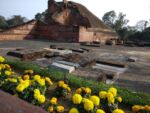- The name Bihar is derived from the Sanskrit and Pali word, Vihāra , meaning “abode”. The region roughly encompassing the present state was dotted with Buddhist vihara, the abodes of Buddhist monks in the ancient and medieval periods.
- Medieval writer Minhaj al-Siraj Juzjani records in the Tabakat-i-Nasiri that in 1198, Bakhtiyar Khalji committed a massacre in a town now known as Bihar Sharif, about 70 km away from Bodh Gaya.
- Medieval writer Minhaj al-Siraj Juzjani records in the Tabakat-i-Nasiri that in 1198, Bakhtiyar Khalji committed a massacre in a town now known as Bihar Sharif, about 70 km away from Bodh Gaya.
- Chirand, on the northern bank of the Ganga River, in Saran district, has an archaeological record from the Neolithic age (about 2500–1345 BC). Regions of Bihar—such as Magadha, Mithila and Anga—are mentioned in religious texts and epics of ancient India.
- Mithila gained prominence when people of Āryāvarta (an ancient name for India) established the Videha Kingdom. During the late Vedic period (c. 1100-500 BCE), Videha became one of the major political and cultural centers of South Asia, along with Kuru and Pañcāla. The kings of the Videha Kingdom were called Janakas. Sita, a daughter of one of the Janaks of Mithila is mentioned as the consort of Lord Rama, in the Hindu epic, Ramayana, written by Valmiki. The Videha Kingdom later became incorporated into the Vajji confederacy which had its capital in the city of Vaishali, which is also in Mithila.
- Vajji had a republican form of government where the king was elected from the number of rajas. Based on the information found in texts pertaining to Jainism and Buddhism, Vajji was established as a republic by the 6th century BCE, before the birth of Gautama Buddha in 563 BCE, making it the first known republic in India.
- The region of modern-day southwestern Bihar called Magadha remained the centre of power, learning, and culture in India for 1000 years. The Haryanka dynasty, founded in 684 BC, ruled Magadha from the city of Rajgriha (modern Rajgir). The two well-known kings from this dynasty were Bimbisara and his son Ajatashatru, who imprisoned his father to ascend the throne.
- Ajatashatru founded the city of Pataliputra which later became the capital of Magadha. He declared war and conquered the Vajji. The Haryanka dynasty was followed by the Shishunaga dynasty. Later the Nanda Dynasty ruled a vast tract stretching from Bengal to Punjab.
- The Nanda dynasty was replaced by the Maurya Empire, India’s first empire. The Maurya Empire and the religion of Buddhism arose in the region that now makes up modern Bihar. The Mauryan Empire, which originated from Magadha in 325 BC, was founded by Chandragupta Maurya, who was born in Magadha. It had its capital at Pataliputra (modern Patna). The Mauryan emperor, Ashoka, who was born in Pataliputra (Patna) is believed to be one of the greatest rulers in the history of the world.
- The Gupta Empire, which originated in Magadha in 240 AD, is referred as the Golden Age of India in science, mathematics, astronomy, commerce, religion, and Indian philosophy. Bihar and Bengal was invaded by Rajendra Chola I of the Chola dynasty in the 11th century.
- Buddhism in Magadha went into decline due to the invasion of Muhammad bin Bakhtiyar Khalji, during which many of the viharas and the famed universities of Nalanda and Vikramashila were destroyed.
- After the Battle of Buxar (1764), the British East India Company obtained the diwani rights (rights to administer, and collect revenue or tax) for Bihar, Bengal and Odisha.
- Bihar remained a part of the Bengal Presidency of British India until 1912, when the province of Bihar and Orissa was carved out as a separate province.
- Since 2010, Bihar has celebrated its birthday as Bihar Diwas on 22 March.
- Farmers in Champaran had revolted against indigo cultivation in 1914 (at Pipra) and 1916 (Turkaulia). In April 1917, Mahatma Gandhi visited Champaran, where Raj Kumar Shukla had drawn his attention to the exploitation of the peasants by European indigo planters. The Champaran Satyagraha that followed received support from many Bihari nationalists, such as Rajendra Prasad and Anugrah Narayan Sinha.
- In the northern and central regions of Bihar, the Kisan Sabha (peasant movement) was an important consequence of the independence movement. It began in 1929 under the leadership of Swami Sahajanand Saraswati who formed the Bihar Provincial Kisan Sabha (BPKS), to mobilise peasant grievances against the zamindari attacks on their occupancy rights. The movement intensified and spread from Bihar across the rest of India, culminating in the formation of the All India Kisan Sabha (AIKS) at the Lucknow session of the Indian National Congress in April 1936, where Saraswati was elected as its first president.
BPSC Examination: Quick Historical Facts on Bihar
CSS

